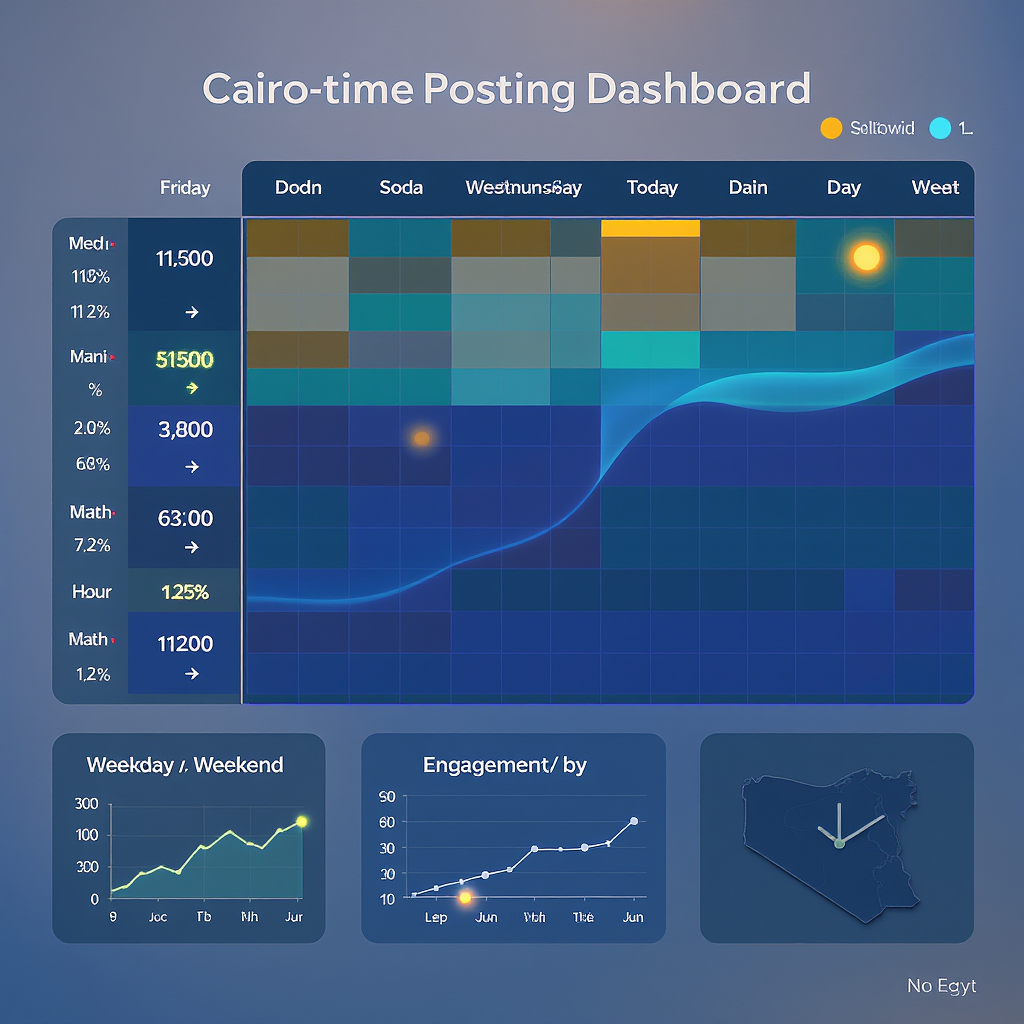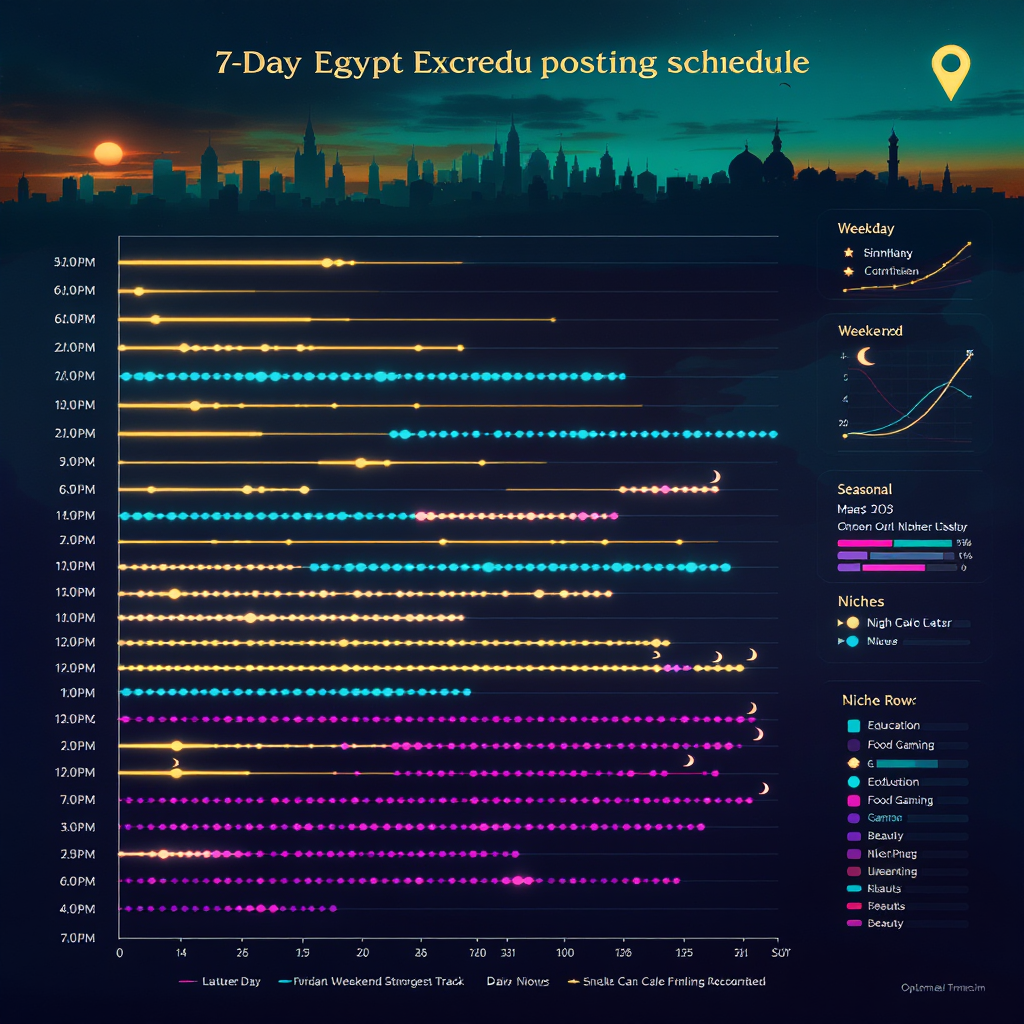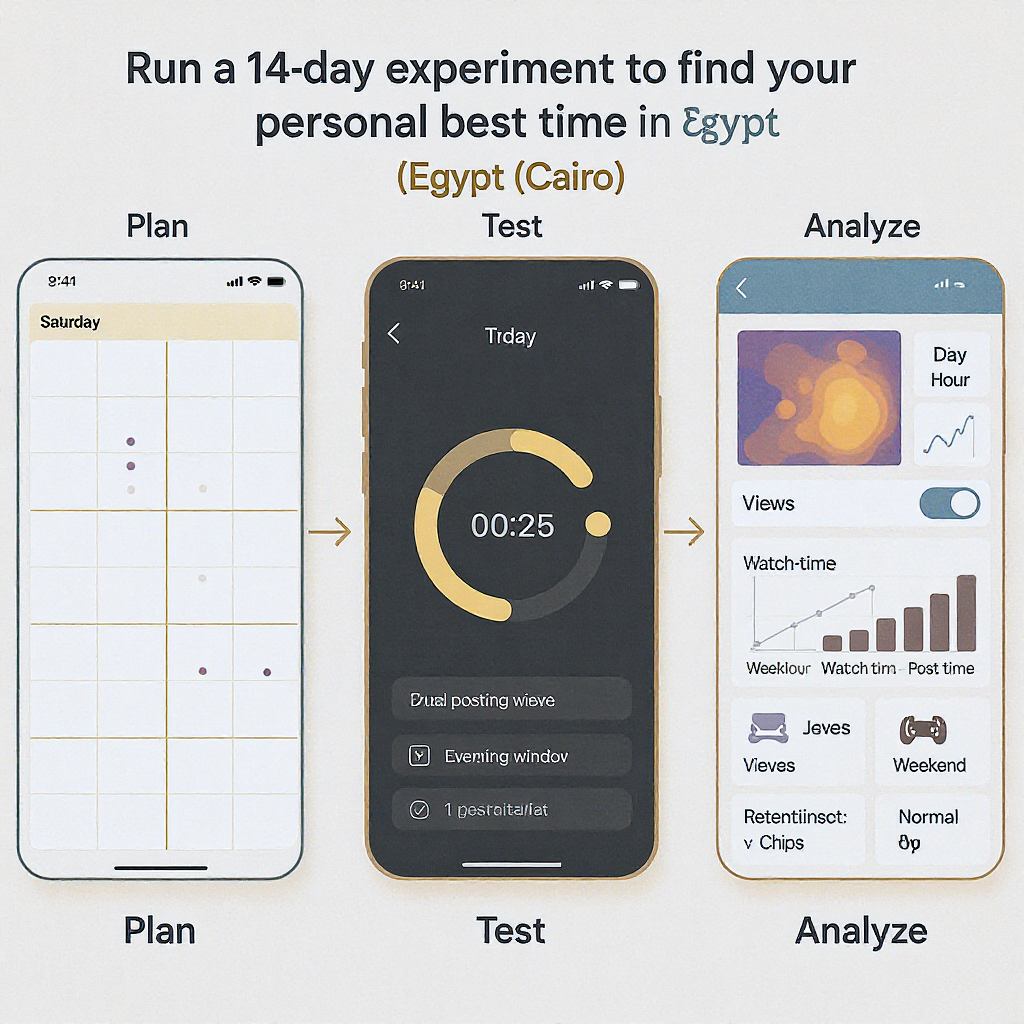Best Time to Post on TikTok in Egypt (Cairo Time): Data Windows, Weekend Patterns, and Ramadan Tips
Find the best time to post on TikTok in Egypt with Cairo-time windows, Friday-Saturday behavior, and Ramadan shifts, plus a simple two-week testing plan.

Best Time to Post on TikTok in Egypt (Cairo Time): Data Windows, Weekend Patterns, and Ramadan Tips


This guide distills Cairo-time posting windows, weekend patterns, and Ramadan adjustments so you can publish when your audience is actually scrolling. It combines proven default windows with a simple, repeatable testing framework tailored to Egypt-based creators and brands. Use it as your benchmark, then refine with analytics over a focused two-week cycle.
TikTok rewards timing because the first 30–90 minutes after publishing decide whether your video escapes its initial test group and finds broader audiences. In Egypt, “when” matters even more because:
- Your reference clock is Cairo time (EET, UTC+2; EEST, UTC+3 during daylight saving). Set your scheduler and analytics to this.
- Egypt’s Friday–Saturday weekend reshapes attention spikes, unlike Sunday-weekend markets.
- Daily routines (school, work, family) plus Ramadan and exam seasons shift browsing curves.
Below is a practical, Egypt-specific playbook to get your timing right—and to iterate toward your personal sweet spot.
Quick Answer: Best Posting Windows by Day (Cairo Time)
If you want the TL;DR for “best time to post on TikTok Egypt,” start here. These are strong default windows for Cairo-based audiences:
| Day | Primary Windows (Local Time) | Notes |
|---|---|---|
| Mon–Thu | 12:00–14:00, 18:00–21:00 | Lunch breaks and post-work peaks |
| Friday | 11:00–13:00, 21:00–23:00 | Midday leisure before/after prayer; strong late-night browsing |
| Saturday | 17:00–20:00 | Leisure afternoon through early evening |
| Sunday | 18:00–21:00 | Workweek restarts; evening unwind |
| Early-commute test | 07:00–09:00 (select days) | Try 1–2 days/week, especially Tue–Thu |
Pro tip: Post 30–60 minutes before the center of a window to build momentum by peak time. Avoid “right on the hour” (e.g., 18:00); try 17:53 or 18:07 to dodge scheduling spikes.
Why Timing Matters in Egypt
- TikTok’s distribution starts with a small, relevant slice of your audience. Early watch time, completion rate, and replays tell the algorithm whether to expand reach.
- Cairo time is the reference even if your account managers travel. Keep a shared team clock and label analytics screenshots “EET/EEST.”
- Egypt’s weekend is Friday–Saturday. Expect different rhythms than markets with Saturday–Sunday weekends, especially around Friday prayer and late-night leisure.
Weekday vs. Weekend Behavior in Egypt
- Work/school days (Sun–Thu): Engagement clusters at lunch (12–14) and evenings (18–21). Short breaks favor quick, high-hook videos; evenings support slightly longer narratives.
- Friday dynamics: Midday attention is split around Jumu’ah; late evening (21–23) is consistently strong for entertainment, humor, and social content. If you post near noon, mind local prayer timing by district.
- Saturday leisure: Errands and family time push peaks later (17–20). It’s a great day for beauty, fashion, food, and hangout content.
- Late-night browsing: Egypt has a robust scroll culture after 21:00—especially Friday. Consider testing 22:00–24:00 for gaming and comedy.

Seasonality That Changes the Clock
- Ramadan:
- Pre‑Iftar surge: 60–30 minutes before Maghrib as people unwind and browse while waiting to break fast.
- Post‑Iftar surge: Roughly 1–3 hours after Iftar when families relax.
- Suhoor late night: 23:30–02:30 can be gold for humor, gaming, and snackable food content.
- Tip: Shift your schedule to anchor around Iftar time, which changes daily.
- Eid breaks: Daytime social visits reduce mid-morning attention; evenings grow. Lean into celebratory, shareable posts.
- Summer holidays: Later bedtimes shift peaks 30–60 minutes later; experiment with 19:00–22:00.
- Exam periods (secondary/university): Study blocks push engagement to late evenings and short micro-breaks.
- Daylight saving time: Egypt observes DST part of the year (UTC+2 standard; UTC+3 during DST). Set calendar reminders for the spring/fall switches so your “18:30” stays aligned with audience behavior.
Niche-Specific Timing Advice
- Education: Lunch (12–14) and early evening (18–20). Short explainers for breaks; longer walkthroughs after 19:00.
- Beauty & fashion: Evenings (18–21) and weekend nights (Fri 21–23, Sat 18–20). Try “get ready” and haul content.
- Food: Pre‑meal (11:30–13:30; 17:00–19:00) and late-night cravings (22:00+ on Fri). During Ramadan, focus pre‑Iftar and Suhoor.
- Gaming: Late evening to past midnight (20:00–00:30), strongest Thu–Fri nights.
- News & culture: Morning (07:30–09:30) and noon (12:00–14:00) for timely updates; keep hooks tight.
Run a 14‑Day Experiment to Find Your Personal Best Time
- Baseline: Pull 30–60 days of TikTok Analytics.
- Follower Activity graph: Note daily peaks in local time.
- Audience Territories: Confirm Egypt share; if you’ve got Gulf or diaspora pockets, schedule a secondary slot for them.
- Plan: Choose two daily posting slots inside recommended windows (see template below).
- Execution: Publish 30–60 minutes before the expected peak. Stagger start times (e.g., 12:17, 18:43).
- Variations: On two weekdays, add an early-commute test (07:30–08:45).
- Measurement:
- Track 2-hour metrics: views, 3s views, avg watch time, completion rate, rewatches, shares, comments.
- Note retention curve shape (where drop-offs happen).
- Iterate weekly: Move underperforming slots by ±30–45 minutes. Keep high-retention slots steady.
Simple UTM/notes system (paste in your spreadsheet):
date,time_local,slot,label,hook_variant,topic,video_length_s,posted_early_m,reaches_2h,avg_watch_s,completion_rate,rewatch_rate,shares_2h,comments_2h,notes
2025-03-10,12:17,A,lunch,question,edu-math,28,43,5200,14.2,0.32,0.18,33,12,"good 10s retention bump with subtitle"
2025-03-10,18:43,B,evening,controversy,beauty,21,47,9100,12.6,0.29,0.22,54,27,"thumbnail A beat B"Sample 7‑Day Egypt Posting Schedule (Two Daily Slots)
Use this as a starting template. Adjust ±15–45 minutes based on your analytics.
| Day | Slot A (Publish) | Slot B (Publish) | Stories (Warm-Up) | Live (Optional) |
|---|---|---|---|---|
| Monday | 12:30 | 19:15 | 11:45, 18:30 | — |
| Tuesday | 08:05 (test) | 18:50 | 07:30, 18:05 | — |
| Wednesday | 12:10 | 20:05 | 11:30, 19:10 | 19:30–20:00 (pre-post) |
| Thursday | 13:20 | 19:40 | 12:30, 18:50 | — |
| Friday | 11:20 | 22:05 | 10:40, 21:15 | 22:15–22:45 (gaming/entertainment) |
| Saturday | 17:25 | 19:10 | 16:45, 18:25 | — |
| Sunday | 18:20 | 20:10 | 17:40, 19:25 | — |
- Stories/Live purpose: Warm your active audience 30–60 minutes before main posts to nudge algorithmic interest.
- Friday note: Be mindful of local prayer times; if needed, shift Slot A slightly earlier or later within the 11:00–13:00 window.
Workflow and Tools
- TikTok’s native scheduler: Set it to Cairo time and double-check after app updates.
- DST reminders: Add two calendar alerts each year—one week before the switch and on the day—to reconfirm posting slots.
- Batch creation: Film 6–12 hooks in one session; keep a “hooks bank” to A/B test first 1–2 seconds.
- A/B hooks: Repost the same core video with two opening hooks a week apart, same slot, to isolate timing vs. creative.
- Tracking: Use the CSV schema above or your project management tool to tie timing to performance.
Ramadan Timing Cheatsheet
During Ramadan, re-anchor to Iftar and Suhoor rather than fixed hours.
| Phase | Typical Local Window | Why It Works | Content Tips |
|---|---|---|---|
| Pre‑Iftar | −60 to −15 minutes before Maghrib | High anticipation and downtime | Quick recipes, light humor, last-minute tips |
| Post‑Iftar | +45 to +180 minutes after Maghrib | Family relaxes; social sharing rises | Longer storytelling, culture, family content |
| Suhoor | 23:30–02:30 | Late-night scroll culture peaks | Gaming, comedy, snack ideas, Q&A Lives |
Mistakes to Avoid
- Using US or UK timing advice for Egypt. Local rhythms differ.
- Ignoring Ramadan, Eid, exams, or DST shifts.
- Posting exactly on the hour. Stagger a few minutes to avoid crowded release moments.
- Overposting back-to-back in the same hour. Give videos breathing room to find their audience.
- Judging a slot by one video. Use 3–5 data points per slot before deciding.
Quick FAQs
- How often should I post in Egypt? Aim for 1–2 high-quality posts daily. Consistency beats volume.
- Should I cross‑post Instagram Reels? Yes, but natively upload and adjust captions/hashtags for each platform. Align timing with local peaks on both apps.
- When should I pivot timing? If a slot underperforms across 3–5 comparable videos (same hook length and topic), shift it by 30–45 minutes or replace it with an early-commute/late-night test.
- Do niche differences beat general windows? Yes. Start with the windows above, then let your retention and rewatch data pull you toward niche-specific peaks.
Final Word
Use the listed Cairo-time windows as a reliable starting point, but treat timing as a living system. Track two slots daily, experiment around weekends and Ramadan, and read your retention curves. With a disciplined 14‑day test-and-iterate cycle, you’ll find your own best time to post on TikTok in Egypt—and protect it as seasons, schedules, and the clock change.
Summary
- Set all tools to Cairo time, post slightly before peak windows, and avoid on-the-hour drops.
- Use the provided default windows, then run a 14-day test to refine by niche, season, and Ramadan patterns.
- Keep iterating in ±30–45-minute steps, guided by watch time, completion, and rewatch rates.




